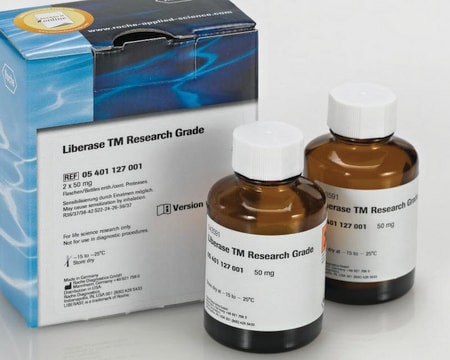Wszystkie zdjęcia(1)
Key Documents
10104159001
Roche
DNase I
grade II, from bovine pancreas
Synonim(y):
Deoxyribonuclease, Deoxyribonucleate 5′-oligonucleotido-hydrolase
Zaloguj sięWyświetlanie cen organizacyjnych i kontraktowych
About This Item
Kod UNSPSC:
12352204
Polecane produkty
pochodzenie biologiczne
bovine pancreas
Poziom jakości
Postać
lyophilized
opakowanie
pkg of 100 mg
producent / nazwa handlowa
Roche
metody
DNA extraction: suitable
optymalne pH
~7.0
temp. przechowywania
2-8°C
Powiązane kategorie
Opis ogólny
Bovine pancreatic deoxyribonuclease I (DNase I) is a DNA minor grove-interacting nuclease which shows relatively low specificity. This protein is composed of two central β sheets, each composed of six β-strands. This structure is surrounded by extensive loop and α-helical regions. This enzyme shares structural similarity to exonuclease III. DNase I is one of the most well characterized endonucleases of mammalian origin. It is a double-strand-specific endonuclease that requires bivalent cations for maximal activity.
Zastosowanie
Isolation procedures for proteins (e.g., membrane proteins).
Bovine pancreatic deoxyribonuclease I (DNase I) has been used for-
Bovine pancreatic deoxyribonuclease I (DNase I) has been used for-
- The isolation of cells from lung, skin and tumor samples
- Bacterial DNA extraction from live bacterial cells that are resistant to DNase I †
Definicja jednostki
One unit is the enzyme activity that causes an increase in the absorbance of 0.001 per minute under assay conditions.
Uwaga dotycząca przygotowania
Activator: Ca2+ (0.12 mM) in combination with Mg2+ enhances activity [Laskowski (1971); Melgar and Goldthwait (1968)].
Working concentration: 1 mg/ml
Do not vortex while dissolving!
Storage conditions (working solution): Reconstituted in water, the solution can be kept for 2 to 3 days at 2 to 8 °C. Do not vortex during dissolving. Note: Dissolve at least 1 mg/ml.
Working concentration: 1 mg/ml
Do not vortex while dissolving!
Storage conditions (working solution): Reconstituted in water, the solution can be kept for 2 to 3 days at 2 to 8 °C. Do not vortex during dissolving. Note: Dissolve at least 1 mg/ml.
Inne uwagi
For life science research only. Not for use in diagnostic procedures.
This page may contain text that has been machine translated.
Hasło ostrzegawcze
Danger
Zwroty wskazujące rodzaj zagrożenia
Zwroty wskazujące środki ostrożności
Klasyfikacja zagrożeń
Resp. Sens. 1 - Skin Sens. 1
Kod klasy składowania
11 - Combustible Solids
Klasa zagrożenia wodnego (WGK)
WGK 1
Temperatura zapłonu (°F)
does not flash
Temperatura zapłonu (°C)
does not flash
Certyfikaty analizy (CoA)
Poszukaj Certyfikaty analizy (CoA), wpisując numer partii/serii produktów. Numery serii i partii można znaleźć na etykiecie produktu po słowach „seria” lub „partia”.
Masz już ten produkt?
Dokumenty związane z niedawno zakupionymi produktami zostały zamieszczone w Bibliotece dokumentów.
Klienci oglądali również te produkty
Ting Zhou et al.
Nature, 583(7817), 609-614 (2020-06-26)
Cytokines were the first modern immunotherapies to produce durable responses in patients with advanced cancer, but they have only modest efficacy and limited tolerability1,2. In an effort to identify alternative cytokine pathways for immunotherapy, we found that components of the
Alejandro A Pezzulo et al.
Applied and environmental microbiology, 79(19), 5936-5941 (2013-07-23)
Human lungs are constantly exposed to bacteria in the environment, yet the prevailing dogma is that healthy lungs are sterile. DNA sequencing-based studies of pulmonary bacterial diversity challenge this notion. However, DNA-based microbial analysis currently fails to distinguish between DNA
James Cahill et al.
Bio-protocol, 10(6), e3551-e3551 (2021-03-05)
Nucleotide-sugar transporters (NSTs) facilitate eukaryotic cellular glycosylation by transporting nucleotide-sugar conjugates into the Golgi lumen and endoplasmic reticulum for use by glycosyltransferases, while also transferring nucleotide monophosphate byproducts to the cytoplasm. Mutations in this family of proteins can cause a
Mitsuteru Natsuizaka et al.
American journal of cancer research, 4(1), 29-41 (2014-02-01)
Insulin-like growth factor binding protein 3 (IGFBP3), a hypoxia-inducible gene, regulates a variety of cellular processes including cell proliferation, senescence, apoptosis and epithelial-mesenchymal transition (EMT). IGFBP3 has been linked to the pathogenesis of cancers. Most previous studies focus upon proapoptotic
M Salimi et al.
Clinical and experimental dermatology, 41(5), 552-556 (2016-01-26)
Studying skin immune cells under various pathophysiological conditions is vital for understanding the nature of cutaneous inflammatory responses. Available methods of isolating cells from the skin have relatively low yield or require in vitro culture. To increase the effective isolation
Nasz zespół naukowców ma doświadczenie we wszystkich obszarach badań, w tym w naukach przyrodniczych, materiałoznawstwie, syntezie chemicznej, chromatografii, analityce i wielu innych dziedzinach.
Skontaktuj się z zespołem ds. pomocy technicznej














